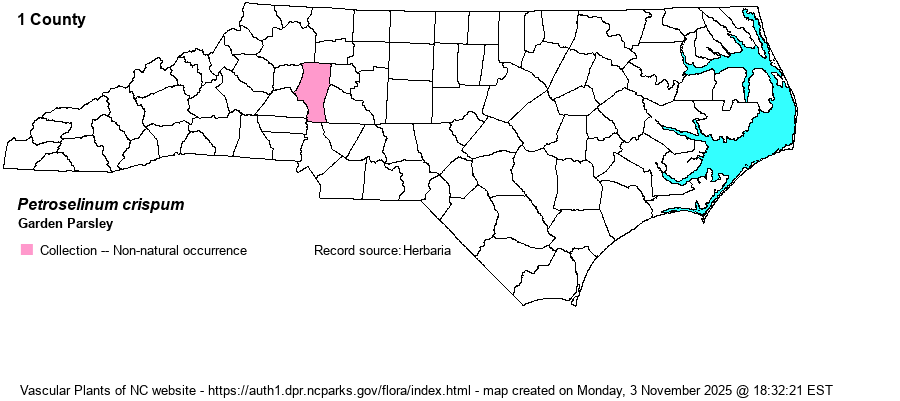| Author | (P. Miller) Nyman ex Hill | |
| Distribution | There are no unequivocally non-cultivated specimens at SERNEC. The Iredell specimen (cited in RAB 1968) is by M. Hyams and cannot be relied on regarding provenance. Specimens from Alleghany and Jackson counties do not have enough data on the labels to be certain of wild-collected plants or not. Specimens from Chatham, Orange, and Wake counties are all from cultivated plants. A specimen from Watauga County is Pastinaca sativa. Taxon editors seek specimen(s) with higher quality data, before truly accepting Garden Parsley to the NC flora. However, for the time being, at least as a "place-holder", the Iredell County collection is mapped below, as RAB (1968) state "A rare escape from cultivation" -- suggesting that it was probably not taken directly from a garden.
Native of Mediterranean Europe; in N.A. scattered in the U.S. and southern Canada. | |
| Abundance | The editors will continue to keep the species as SE (Exotic) for now, as we cannot completely rule out all collections -- i.e., Iredell, Alleghany, and Jackson counties -- as being from cultivated plants. | |
| Habitat | Disturbed places. | |
| Phenology | Flowering and fruiting June-July. | |
| Identification | Garden Parsley is a familiar cultivated plant, for it aromatic leaves. It is a bushy-branched herb growing to 1.5-3 feet tall, with leaves mostly tri-pinnately compound, into fern-like segments. The numerous umbels have yellowish or greenish flowers, hardly striking. | |
| Taxonomic Comments | | |
| Other Common Name(s) | Often simply known as Parsley. | |
| State Rank | SE | |
| Global Rank | GNR | |
| State Status | | |
| US Status | | |
| USACE-agcp | | |
| USACE-emp | | |

